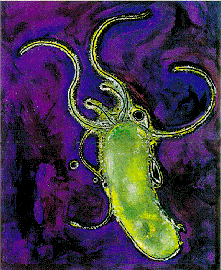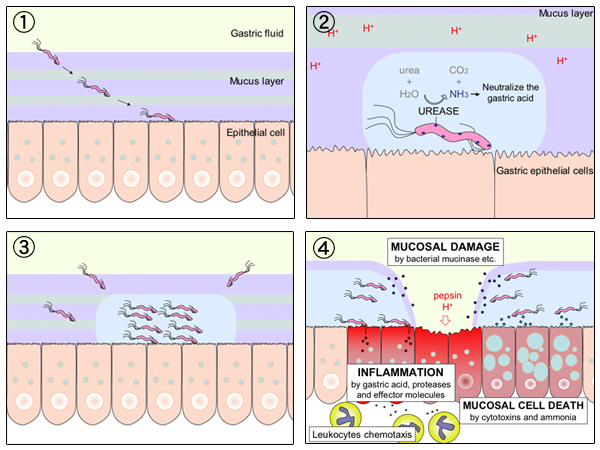The Circle of Life
Helicobacter pylori is most commonly passed from host to host through a fecal-oral route. So, needless to say, H. pylori is much more common in areas around the world, such as third world countries, where health and hygiene standards are low. This can happen through contaminated food or water. However, new studies have shown data that an oral-oral route may also be possible.
To begin its travels to your stomach, the cell enters the mouth and travels down the esophagus, where the pH, or acidity, is neutral. When it reaches your stomach, the pH becomes much more acidic. Most microorganisms would be killed but not H. pylori! Here it buffers its internal structures and surroundings through the enzymic activity of urease. To see how this is done, click here.
Once it is in the stomach, it rapidly enters the mucous layer that surrounds the walls of the stomach (mucosa) to protect it from the gastric fluids. Here it multiplies itself in the same way most bacteria reproduce themselves, through binary fission. Binary fission can be explained in a few simple steps. (1) The bacterium replicates its DNA. (2) The bacterium then separates its newly created chromosome from the other. (3) Cytokinesis then occurs, and the cell is split into two new daughter cells.
1)
H. pylori invading mucous layer
2)
H. pylori neutralizing surroundings using the enzymic
activity of urease
3)
H. pylori colonizing mucous layer
4)
H. pylori causing inflammation, mucosal degredation, and cell death
Helicobacter pylori can then be passed through the digestive system and excreted through the anus in feces. If contaminated feces gets in the food or water supply, the circle will then be completed!
To learn more about the damage Helicobacter pylori can cause its host, click here.


